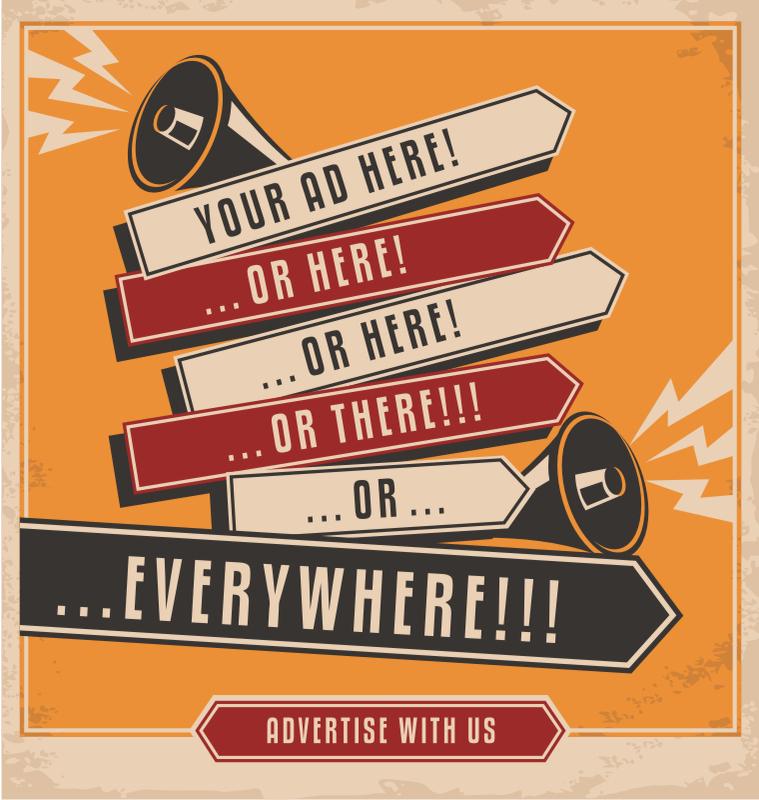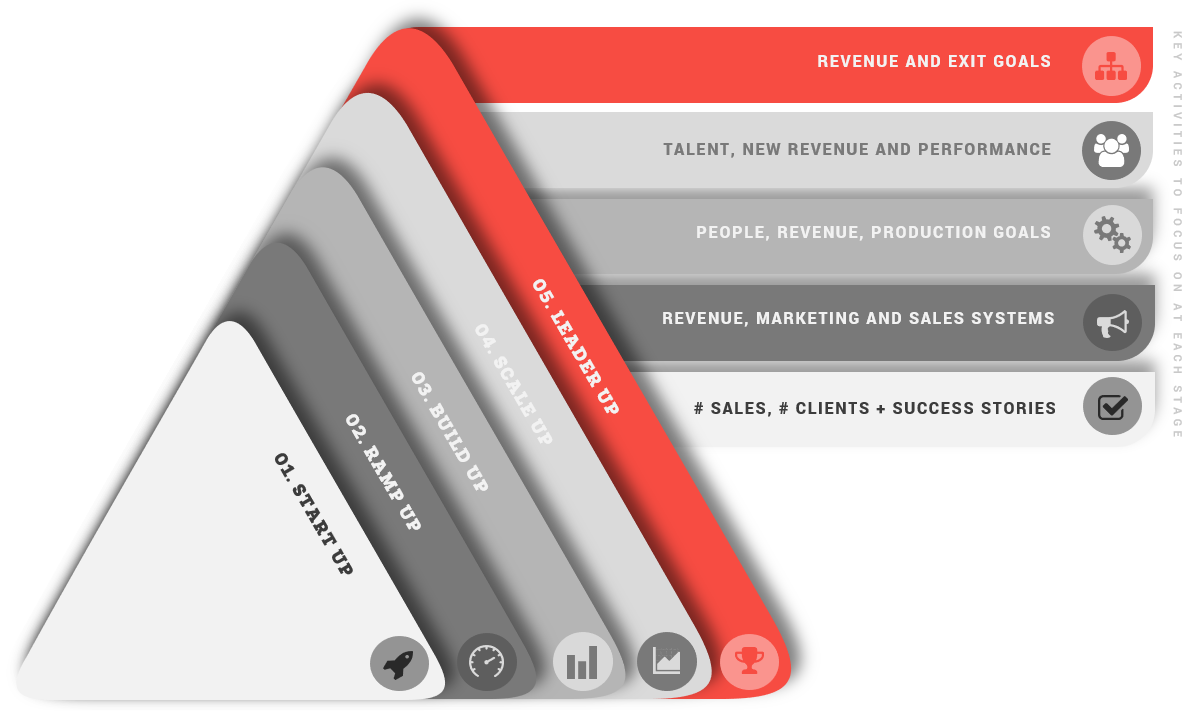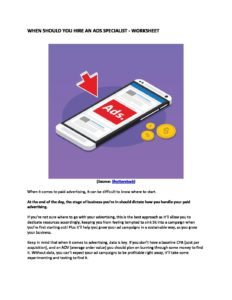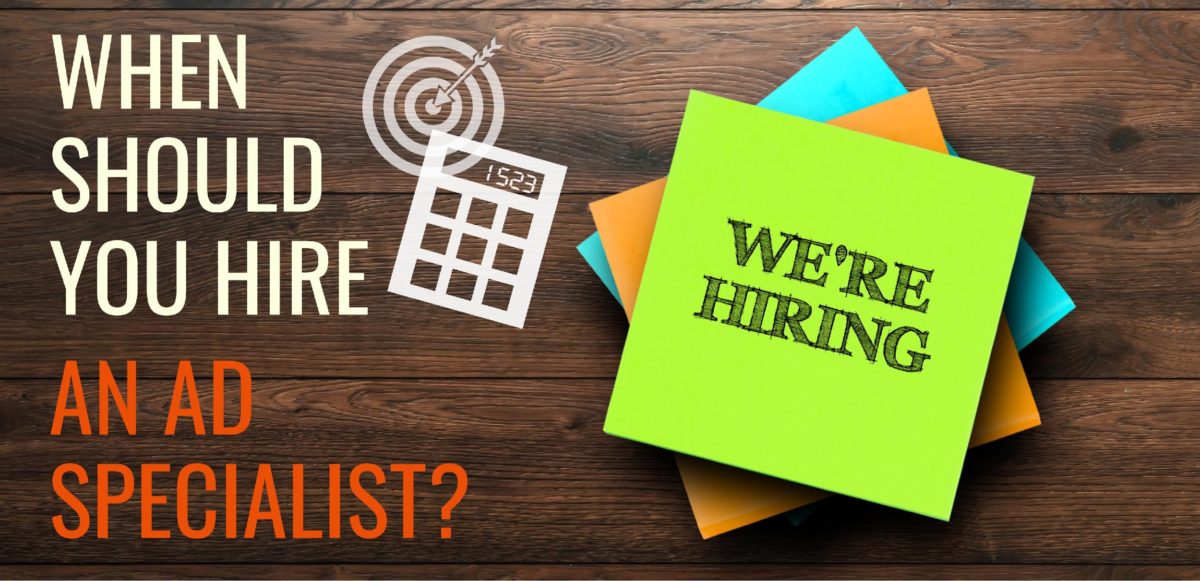When it comes to paid advertising, it can be difficult to know where to start. There’s no shortage of options out there, and plenty of conflicting opinions on which one’s best; with each platform touting their approach and ad features as the most effective.
From Facebook Ads, to Google Ads, LinkedIn Advertising, Twitter Ads, YouTube, and so much more. And once you’ve decided on a platform, there’s the issue of what type of ad campaign you should run. (Retargeting? Cold traffic?)
We all want to get the most out of our ad dollars, but how can you ensure that you’re putting your money to the best use? Maybe it’s time to bring on an ad professional, but then again there’s the issue of cost –can you really afford to hire someone in-house right now?
At the end of the day, the stage of business you’re in should dictate how you handle your paid advertising.

If you’re not sure where to go with your advertising, this is the best approach as it’ll allow you to dedicate resources accordingly, keeping you from feeling tempted to sink 5k into a campaign when you’re first starting out! Plus it’ll help you grow your ad campaigns in a sustainable way, as you grow your business.
Keep in mind that when it comes to advertising, data is key. If you don’t have a baseline CPA (cost per acquisition), and an AOV (average order value), then you should plan on burning through some money to find it. Without data, you can’t expect your ad campaigns to be profitable right away, it’ll take some experimenting and testing to find it.
On the other hand though, if you already have a baseline CPA and AOV (bonus if you know your customer’s LTV – Lifetime Value), it will make it easier for an outside agency or person to look at the data and see what can be tweaked.
Also keep in mind that your CPA will vary considerably from platform to platform, so if you are measuring success based solely off of whether you can acquire a customer at the same price, you will be disappointed.
Also bear in mind that patience is key when handing over the reins to someone else. When a company or expert takes over your advertising, it is going to take time to get to know the business and the customer base, so don’t expect immediate results.
There are four basic ways companies handle advertising:
- An agency that handles everything
- An agency that specializes in one particular platform
- A freelancer that specializes in a platform
- Hiring in-house
You could use a blend of the above, or, you could handle everything yourself.
But which approach is best for your company?
Let’s find out now.
The Five Stages of Business: Which One Are You In?
Using Todd Herman’s Five Stages of Business model, let’s take a look at ideas for advertising campaigns in each stage of your business.
As Todd says, “When you stay focused on the right things for growth and have a solid framework to help you consistently achieve your goals, your business is more likely to last longer and continually advance through the stages of business…”
Following this structure down through the different stages makes a lot of sense from an advertising perspective as well.

(Source: Todd Herman)
Tip: If you’re not sure what stage you’re in, head over to Todd Herman’s Five Stages of Business and take a look at the different stages.
The Start Up Stage
“Validate your product or service and find your pocket of people to serve.” –Todd Herman
If you are in the Start Up Stage, you are usually bootstrapping and that means doing a lot of things yourself. This is certainly true when it comes to advertising. The truth is though, that in most cases, this is the best way for most startups to start out, as you should be focusing on one channel or one paid traffic source.
This usually requires you to learn about it yourself –and gives you a chance to see what works, what doesn’t –and what’s best for your business, and it’ll help you to spend your ad dollars wisely –crucial as you start to grow and there’s a lot more financially at stake.
Ideally, all business owners should take the time to learn a little bit about paid ads so that when you get to the next stages, you have a working knowledge of the platforms and what they can do.
Start by identifying your target audience –if you haven’t done so already. Then validate your idea.
Then get some ads running. I’d recommend starting with Facebook Ads, just because they’re simple to get started with, and offer some pretty cool features as well. There’s also a good chance that your target market is on there. But if you’d rather start with a different platform, that’s fine too.
Establish a baseline for cost per acquisition, and have a plan for targeting. This will allow you to evaluate your progress, showing you what’s working and helping you to ensure that you operate within budget. Track what’s working –and what isn’t, and repeat your successes.
As far as budgeting when you’re first starting out, you will most likely have a good idea about how much you can spend on ads. If you feel that there’s room for up to $300-$500 on ads per month, then do that. It’s a good, safe way to test the waters and see what will work. As a very rough guideline, most companies spend about 5% to 15% of their revenue on marketing.

Get our When Should You Hire a Paid Ads Specialist Worksheet delivered right to your inbox.
The Ramp Up Stage
“Focus your juggling time on marketing, sales and product.” –Todd Herman
In the Ramp Up Stage, you are starting to add additional traffic sources and platforms to your ad strategy.
By now, your focus is going to be on establishing processes in your company so trying to learn everything about all of the other advertising platforms is going to be nearly impossible.
As Todd Herman says, “For Ramp Up Businesses, any mental, creative, and physical energy directed anywhere but marketing, sales and product systems is misdirected – and will keep you stuck in this stage for far too long.”
So focus your attention on ensuring you can differentiate yourself from the competition, building your sales and marketing systems, and optimizing your conversion strategy. You’ll also want to find the single most important marketing channel for attracting new customers.
From an advertising perspective, you’ll want to either hire people to fill in the operations so you can focus on the advertising, or you should be looking to hire for the advertising itself. Both approaches have their pros and cons; it’s largely a matter of what you enjoy and where your time would be most valuable.
Usually, at this stage, business owners will look for an agency that can do it all to help simplify things as much as possible. While this approach has one distinct advantage, it allows you to expand quickly across multiple platforms –but it also has its downside.
With agencies, you’ll usually find that they’re good at one or two platforms but just average with the rest. No offense to my friends who own agencies, I realize that there are some exceptions here!
At this stage, you most likely won’t have the bandwidth to hire in-house, and you wouldn’t have the knowledge base to train that person. The agency will help you get a baseline acquisition cost on the other platforms, but you are going to be one of many clients that they handle, so you won’t have their full attention.
The Build Up Stage
“Get your operational house in order.” –Todd Herman
In the Build Up Stage, you’ll want to start focusing more on long-term infrastructure. Work on establishing your systems for scaling.
For ad campaigns at this point, you should have a baseline for each platform. Now you are looking to optimize and push as much money as you can into the ad campaigns –now that you’re certain you’re targeting the right audience, and have a good idea about which ads will generate results.
This is where the all-inclusive agency’s capabilities start to cap out.
Some of my clients have hired in-house at this stage, but in most cases, I wouldn’t recommend it. With an agency, you’ll still be getting a one-to-many ratio on their attention, but you’ll also be getting the benefit of learning from the best practices from other clients on the same platform –which can be helpful when you’re still learning the ropes yourself.
At this stage, I would start looking for platform-specific agencies, or freelancers, depending upon your budget. This will end up costing you more for account management, but they will often be more educated on the latest strategies and how to really optimize your campaigns to reduce cost per acquisition and increase conversions.
The Scale Up Stage
“Develop your team, culture and leadership.” –Todd Herman
In the Scale Up Stage, your focus should be on focusing on your growth strategy, and developing the leaders of your business. By now, you’ll have a solid infrastructure in place, one that can scale as your business grows.
This is where you may decide to bring someone in-house. By now you know what is working and what isn’t working for your niche, and now you want to have someone dedicated to JUST optimizing the campaigns.
For my company, I didn’t bring it in-house but I had someone that managed all of the outsourced freelancers and agencies (which was me). This is where you start to build a cohesive team, whether in-house or outsourced, and should begin focusing on creating a congruent message across all platforms. Consistency is vitally important once you’ve reached this stage of the game.
The Leader Up Stage
“Protect your position through acquisition and innovation.” –Todd Herman
Finally, we arrive at the Leader Up Stage. If you’ve made it here in your business, congratulations! This is the final stage; the top of the mountain so to speak, and one that many companies don’t make it to.
At this stage, it’s about finding a way to continue long-term sustainability for your business, and your primary focus should be the recruitment of top talent. A key challenge at this point is that you’re less agile, and would find it harder to pivot if a game-changing innovation arrives on the scene.
When it comes to advertising at this point, you’ll largely want to carry on from Scale Up Stage, and continue to hire your core team members in-house. By this point, you should have a brand guide for consistency across all aspects of your advertising and marketing, with standards on everything from colors and fonts to how your voice and tone on different social media platforms.
So there you have it! A handy blueprint for implementing advertising campaigns at each stage of the game. Hopefully, this will help you if you’re stuck and looking for answers on what team members to hire, and where you should be focusing your efforts when it comes to advertising.
Which stage are you in? Share what you’re doing for advertising in the comments!

Get our When Should You Hire a Paid Ads Specialist Worksheet delivered right to your inbox.







